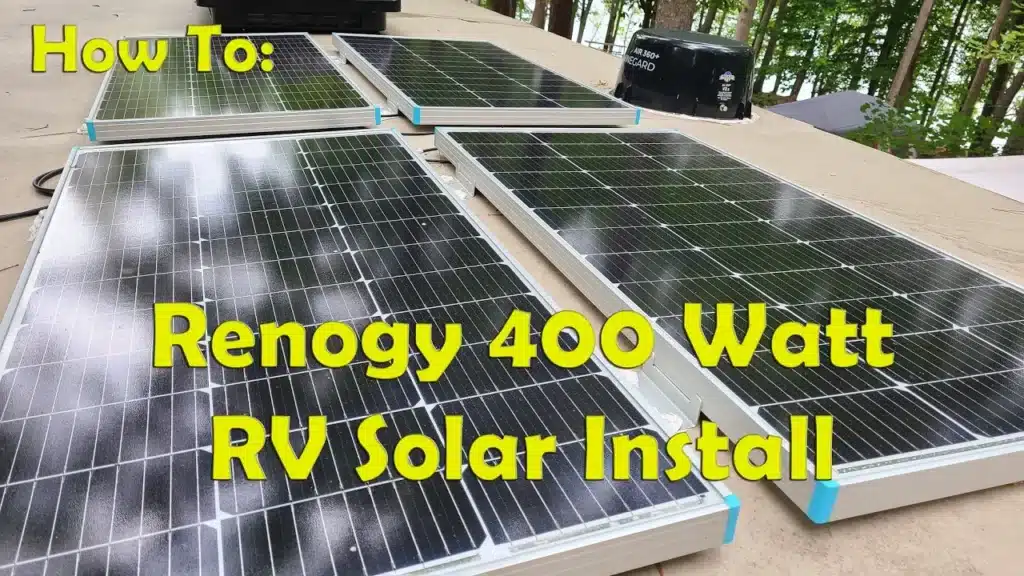We’ve all seen these guys with one million watts of RV Photo voltaic panels on their roof, and 30 batteries within the stomach of their camper boasting how they will run each of their AC items and an air fryer whereas they watch TV of their rig. This text isn’t about a type of techniques, I’m not that man.
My Spouse and I’ve been residing on the highway full time in our RV for a few yr now.
We tried our hand at Boondocking at a Harvest Hosts one evening, and at 2 a.m. the low battery alarm began going off. Hell we didn’t even make it in the future, we left our campground with full hookups at 9 a.m., bought there at midday, and 14 hours had no juice left.
Nicely now we have to work out a method to preserve sufficient cost within the batteries in order that I would be capable of sleep till dawn. We hadn’t accomplished ANY analysis in any respect on RV Photo voltaic, however then I got here throughout the 400 Watt RV Photo voltaic Equipment from Renogy.
It appeared to have every little thing we wanted to throw some panels on the roof, and preserve our batteries charged sufficient to have the ability to use the lights within the kitchen and preserve our low battery alarm from going off, so we ordered it.
We ordered it from Amazon, and it confirmed up at my buddies home in 3 days, and it did include ALMOST every little thing we wanted to finish the set up. The one issues it didn’t include was the roof sealant, and a move by means of for the wires to go from the roof down and into the RV, however we ordered these as nicely, so now we had been able to go.
You’ll be able to watch my brief Set up video right here: Renogy RV Photo voltaic Equipment Set up
The RV Photo voltaic package from Renogy comes with 4 100 Watt Photo voltaic Panels, a 10 amp inline fuse, panel combiner plugs, cables to go from the roof to the cost controller, a 40 amp MPPT Cost Controller, a Battery fuse, a Bluetooth antennae so you’ll be able to monitor your energy manufacturing with an App in your telephone, and cables to go from the controller to your batteries.
The instructions for set up had been fairly straight ahead, besides how the panels themselves must be wired collectively on the roof. There are a couple of choices for placing them collectively, and I’ll admit I did it ‘Incorrect’ the primary time. With photo voltaic panels you could have the choice of wiring them in Sequence, Parallel, and Sequence-Parallel.
Trying on the elements readily available, and the included combiner plugs, I assumed they wanted to be wired in Parallel. Which is when all of the Optimistic cables tie collectively, and all of the Unfavourable cables tie collectively, then go all the way down to the Cost Controller. Whenever you wire them this fashion, the entire Amperage from every Panel is added collectively, and on a full Solar day, will pop the ten amp fuse.
I replaced the fuse, and rewired them in Sequence, Optimistic to Unfavourable, Optimistic to Unfavourable, Optimistic to Unfavourable, Optimistic to Unfavourable, then all the way down to the Cost Controller and every little thing began working completely.
We had 200 amp hours of normal outdated Deep Cycle Lead Acid batteries from the manufacturing facility, so we figured that must be sufficient storage to maintain us going. We now have a residential fridge in our RV that runs off a 1,500 Watt Energy inverter that auto switches ON once we unplug the RV at a campground.
IF we ONLY use the 12 volt lighting, and depart the fridge operating like regular, the photo voltaic will cost our batteries throughout the day on a decently Sunny website, and get us by means of the evening with no battery alarms. Realistically that’s all I used to be in search of, so it was doing what it wanted to do, and will get us off grid continuously sufficient that I WOULD spend the cash on it once more if we had been to do it another time.
Pertaining to that topic, of If we had it to do over once more, There are issues I’d do in a different way, like altering out the batteries, and searching into how one can measurement the system to get a sure variety of hours out of it. BUT…
Based mostly solely on, whether or not or not this method carried out as I imagined it will, Sure, it did.
The package got here with most every little thing wanted for the set up, It does cost the batteries throughout the day, and the set up was straight ahead. If you’re in search of a straightforward RV Photo voltaic choice, that may get you off grid for the weekend with out lots of sophisticated math, that is it. Simply ensure you get the roof sealant, and a move by means of, and it couldn’t harm to seize a spare fuse to throw in a junk drawer simply in case.
Keep tuned for my comply with up article on evaluating our RV Photo voltaic vs Generator, and how one can measurement an RV Photo voltaic System to get you thru a complete day of clouds and rain.





